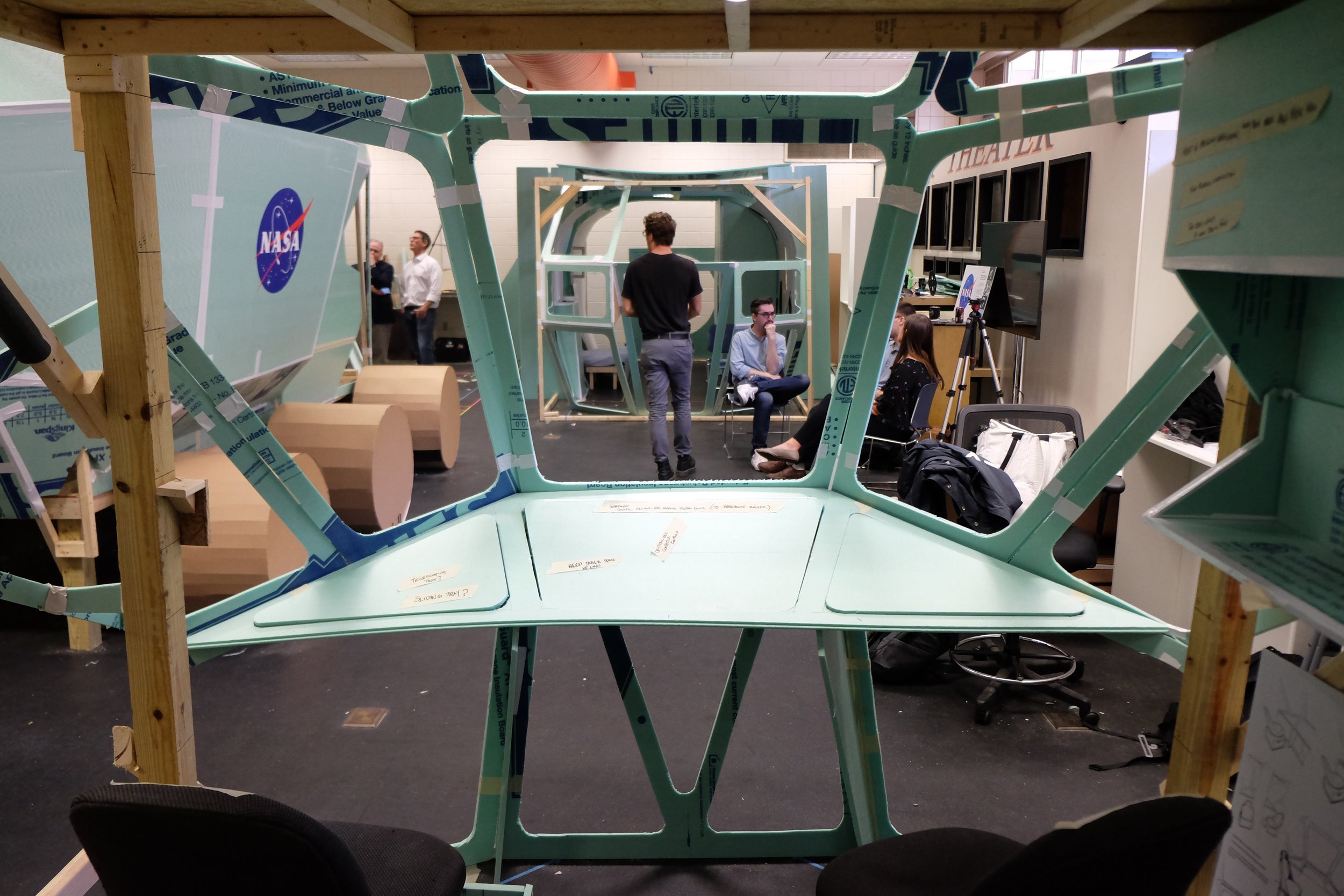NASA Mars Rover (in progress)
My last semester at Auburn, we collaborated with NASA’s human centered design team on developing concepts for the pressurized Mars Rover for their 2030 human-crewed mission to Mars. I enjoyed the mix of design and engineer thinking required in this project.
Rocket Science for Designers
Level 1 Priority - 14 day round trip, support 2 crew members (4 in emergency), docking ability with main habitat, airlock/dust mitigation scheme, carry EVA for each member (4 in an emergency), waste management system, 14.7 psi (livable pressure) - heated, food and water supplies with contingencies
Level 2 Priority - 24” ground clearance, horizontal sleeping (38% gravity of earth), 120 degree view from inside vehicle, robotically refueled and recharged
Level 3 Priority - Robotics for sample collection, towing ability, crab wheels, step out of deep sand
Problems to Solve
Building as a team
After the first presentation, we teamed up to execute a low fidelity rover. We combined many of our individual ideas into one unified rover. It was a “trial and error experiment.”





Breakdown of individual concepts
1. Organic Windows
Organic Windows Using Flat Glass - due to the physical constraint of a pressurized internal environment, the rover’s architecture must maintain a somewhat cylindrical form. However, organic glass pieces are extremely expensive and difficult to manufacture. The individual glass pieces must be flat while the overall form is pieces together to create an organic overall shape.
Floor windows for observation of ground surface.
2. Multi-function Front Dash
It is hard to design interface without knowing what kind of technology will exist in years to come. The challenge here was creating a workspace that would incorporate well with whatever the future has ahead in space tech. The innovation here is a three paneled dash board. The middle section pivots forward landing at a horizontal position. From there, the table unfolds further revealing a work space, eating area, and entertainment surface. This design produces three options: technology board, small horizontal table, and unfolded table in which astronauts can face one another.
The innovation here is a three paneled dash board. The middle section pivots forward landing at a horizontal position. From there, the table unfolds further revealing a work space, eating area, and entertainment surface. This design produces three options: technology board, small horizontal table, and unfolded table in which astronauts can face one another.
3. Food Dispenser & Adjustable Counter
Being on a rover for 14 days going at an incredible pace of 6 miles per hour can really work up an appetite. It is important that thought is put into the action of eating. Astronauts are known to lose their appetite in space, leading to multiple health problems.
This food counter space can unfold, revealing a small counter space to open food packaging. Above the counter is a storage space with clear acrylic reveal the food options of the crew. When the user can see their options, it creates a feeling of more control over their situation.
4. Modular (User Driven) Storage
The rover will carry a large amount of cargo. NASA uses a universal cargo bag to transport everything needed on a mission. These bags are all the same color and sizes, making it difficult to find specific supplies when they are needed.My innovation is that each standardized cargo bag will be color coded or have an icon representing the contents of the bag, while also allowing the bags to attach directly to the wall of the cabin for easy access and display.
The astronauts can rearrange the cargo bags to their preference, even moving some of the bags to the upper bunk section referred to on organic windows page. NASA engineers mentioned the effects of color psychology. Usually during missions only white canvas is used in the cabins - which I explored here.



5. Horizontal & Vertical Ports
We decided to apply two solutions for exiting the rover and connecting to the habitat or other rovers with a vertical connection option and horizontal option. The port that is not in use can be covered up and reconfigured for use in storing trash or other supplies.
Finishing Changes: (4) Modular (User Driven) Storage
Past storage packs problems - White canvas packs, difficulty discerning contents, and 10 in x 17 in x 20 in (with half, double, and triple sizes)
In moving forward, I focused on the modular storage system and evaluating how to discern the contents of each cargo bag. As you can see below, all the bags look the same. What would be an effective solution for knowing the contents at a glance?
Finishing Changes: (3) Food Dispenser & Adjustable Counter space
During the final round of changes, I dug into Human Integration Design Handbook and looked into the types of food used on the International Space Station.
The types of food they use include: 1) Thermo-stabilized - commercially available in tin cans, vacuum sealed 2) Irradiated - exposed to radiation to reduce the risk of food borne illness 3) Rehydratable - prepare by adding hot water
Usually astronauts will “cook” individual elements and then combine them together in zip lock bags. My focus was creating an appliance to meet their food preparing needs all in one place.
Executing Details: In developing a solution, I wanted to include all the functions in one space and arranged in an intuitive way. My design checklist included: heating food, storing food, mixing bags, hydrating food packets, and trash disposal.
Subway doors operate using a horizontal swing hinge. I was interested in replicating that hinge on the cabinets of the food dispenser, allowing the doors to be facing outward even when the appliance is all the way open.
Space Management
Easy Access Food Counter - Understand the motion of the cabinets and counter space within the unit.
Finishing Changes: (2) Multi-Function Front Dashboard
After our second presentation with the Advanced Space Flight concepts team, I made adjustments based on their recommendations by make the side panels stationary and adding additional analog navigation options for the rover.
*This concept is meant to be notional and is intentionally not at final resolution as NASA does not know what kind of navigation and communication technology will be present in the next 10 to 15 years.
A keyboard and manual navigation joystick that can be pushed out of the way when not in use.
Finish Line
The overarching theme of my concepts human empathy: a modular storage design that can be arranged as one pleases and reduces time finding objects, a food system that integrates into the modular design and makes meal prep cleaner, and an adjustable dashboard which offers endless customization.
The Mars rover can be changed and adapted over many missions and by many different kinds of crew members. The goal is longevity in the design.
Closing Remarks
Overall, it was an amazing experience working with NASA’s human-centered design team. This studio was an opportunity to work with engineers, something out of our comfort zone. As a class, we presented many concepts on different topics and still barely scratched the surface of what the final outcome will be.


































